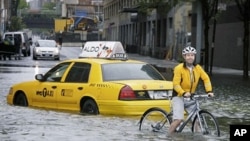Small island nations, such as the Maldives and Kiribati, raised the alarm first. Now larger and more populated places are assessing their vulnerability to sea level rise caused by climate change. A new study suggests millions of American homes could be inundated over the next century. Recognizing the change is one thing, though, and taking action and deciding who pays is another matter.
The latest projections of the impact sea level rise will have on coastal communities appear in the journal Environmental Research Letters. The study authors - from the non-profit Climate Central and University of Arizona - calculated how many people in the United States live less than one meter above the high tide line. And how many is that? Close to 2 million homes sheltering 3.7 million Americans could be flooded by rising seas. The biggest concentrations of vulnerable homes are in Florida, followed by Louisiana, coastal California, and then New York and New Jersey.
Nate Mantua is co-director of the Climate Impacts Group at the University of Washington. He was not involved in the Climate Central study. He said the study’s authors used a novel combination of high resolution elevation, population, and tidal datasets - but didn’t factor in that the rate of sea level rise can differ from place to place.
"They didn't actually consider any specific future sea level rise scenario. Instead, they are using a one-meter increase as a reference and asking how many people would be vulnerable to a sea level rise of one meter. They didn't actually say that's our scenario for 2100."
Other studies have calculated how high the seas could rise regionally due to melting glaciers, disappearing ice caps and the simple expansion in volume of water as it gets warmer. Right now, the world's oceans are rising at an average rate of about 3 millimeters per year. One meter is at the higher end of the range for the end of this century. But Mantua points out there is a great deal of local variation. For starters, the land you live on may be sinking or rising ever so slightly depending on underlying geology.
"You can have this different relative sea level just because the land is not staying still. It's moving. Different parts of the coast are moving up or down at different rates," said Mantua.
There are numerous examples of coastal cities and provinces that have completed vulnerability assessments to rising sea levels. San Diego, New York City and British Columbia, Canada, are three that have done so. Examples of places that have taken some concrete action in response, however, are much harder to find. In the port city of Aberdeen, Washington, public works director Larry Bledsoe thought up an affordable defense. He's recommending the city council progressively raise the minimum elevation of ground floors in new construction.
"It seems prudent to make small adjustments now incrementally before the flood is upon us," said Bledsoe.
Another example from western Washington State: A couple of years ago, Nisqually Wildlife Refuge managers considered sea level rise when designing new dikes to protect freshwater wetlands. The new dikes have an extra wide base so they can more easily be made higher in coming decades.
Margaret Davidson, coast services director for the National Oceanic and Atmospheric Administration, said coping with rising waters requires difficult choices. She looks to the Dutch for confirmation, "because after all, they're been holding back the sea for nearly a thousand years."
"Even the Dutch in their Building with Nature initiative recognize you cannot engineer your way out of everything. We can only save those places that are economically or politically significant. Then we'll have to look at managed retreat and other options for the places that are less so important," said Davidson.
"It's a bit like the options open to the military during a war. We can defend or we can retreat. Both are not very palatable options," she said.
John Clague, an expert on sea level change at Simon Fraser University in Vancouver, Canada, said holding back the waters or relocating inland are both "very, very costly" options.
"Where the money is going to come from, I don't think anyone knows because it's a large amount of money. You know, it's outside the ability, I think, of most communities to deal with this problem, most urban communities in coastal areas," said Clague.
Clague worries about signs that indicate sea level rise is accelerating. His home province of British Columbia is telling its local jurisdictions to prepare for an average rise of about 1 meter over the next century.
News
Study: Rising Seas Threaten Millions of US Homes
- By Tom Banse








